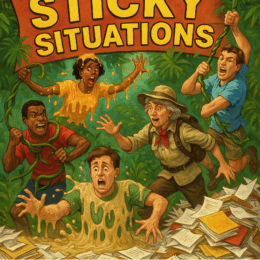
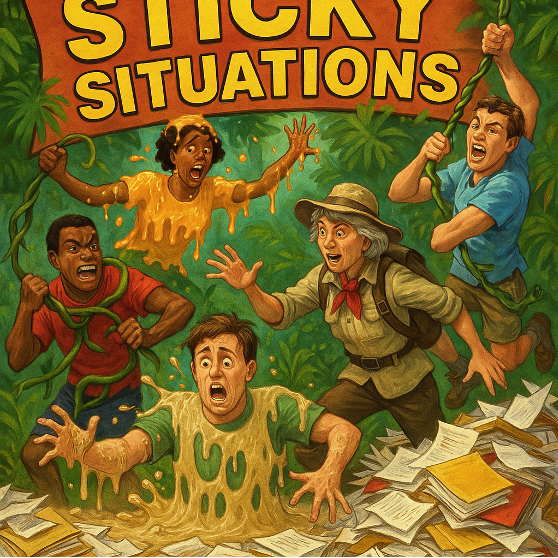
Everyone loves a little drama! Sticky Situations might be your guilty pleasure. Hopefully they aren’t as sticky as the ones the AI-generated image shows. I hope this image is good for a laugh.
Our next NAPO-GPC monthly meeting will be on June 19, 2025 via Zoom. Members will receive their meeting link via email. Guests are encouraged to attend by registering here.
5 pm networking/schmooz-a-rama, new & prospective member Q&A
5:30 pm official start, chapter updates
7 pm meeting wrap
Sticky Situations are moments with clients when our ethics, best business practices, knowledge and experience are challenged. New and veteran organizers alike face these. Sharing them with colleagues can be enlightening. Just like reality TV, discussing sticky situations gives us a chance to get a little dramatic (but in a safe way).
Zoom meeting breakout discussions on each Sticky Situation selected will let us get down and dirty and get to know each other professionally.
Our meeting date falls on Juneteenth, so please check your schedule. Maybe figuring out how to honor a new federal holiday feels like a sticky situation to you? Come join us, as we figure it out together.
Save the date: Our next in person event is our summer picnic taking place on July 17, 2025. Members will receive details in email. Click here to join now.
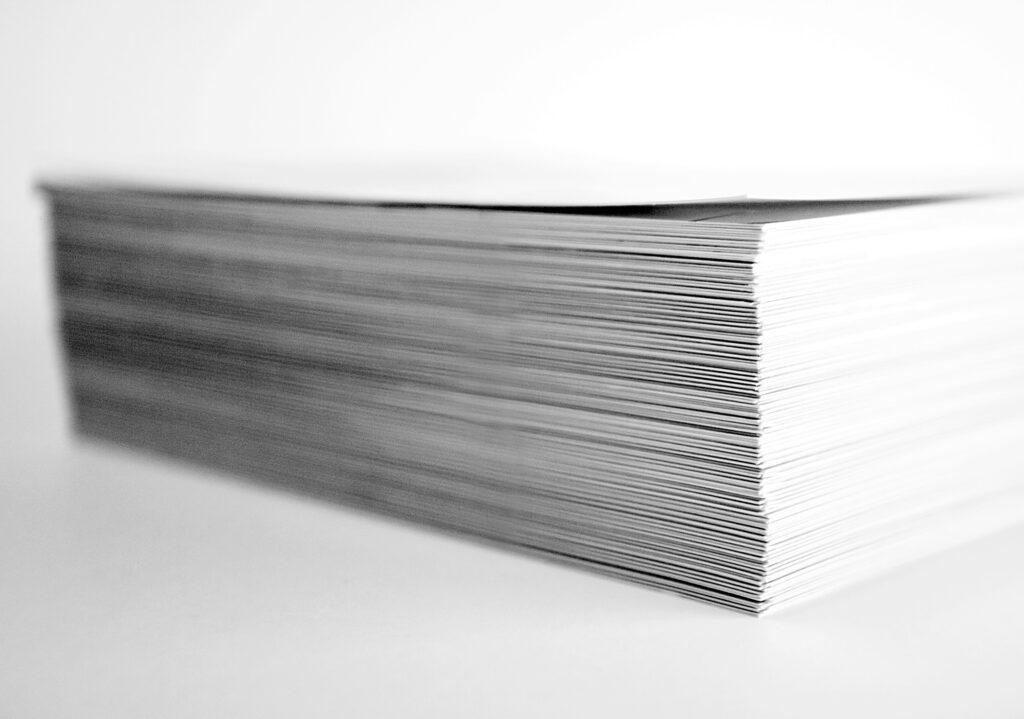
I’ve been reading articles about the promise of a paperless office my entire life, and for the most part, those articles have just created more paper.
For the first time in modern history, we now have the tools to go completely paperless. But before you go invest in a new gadget and hunker down to scan all of your paper, you can probably do a lot to reduce the amount of paper in your life.
If you really want to go paperless, start with these steps to have less paper in your life. You’ll find more space in your home.
The following is excerpted from the best-selling book: Organizing Your Kitchen with SORT and Succeed:
If you want to get healthy, the kitchen is a great place to start. Research shows that cluttered kitchens prompted people to eat 44% more snack food than a kitchen that was organized and decluttered.
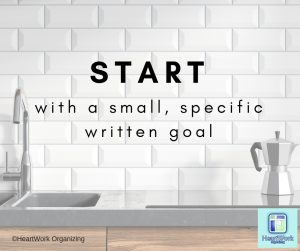
Unless you are working with a paid professional organizer, do not start out with the goal to organize your entire kitchen. For most people, it’s just too big of a goal to accomplish in the ideal project timeframe of between fifteen minutes and four hours.
Clear the sink
Clear the countertop
Remove or re-organize magnets and notes stuck to the refrigerator door
Baking supplies
Cleaning supplies
Pantry items
Small appliances
Everyday dishes
Grill, picnic and party gear
Refrigerator (inside)
Freezer (inside)
Towels, napkins, placemats and tablecloths
Pick one of these mini-projects, or choose something that’s specific to your kitchen, and write down your goal. It can be a single bullet point. It can be on scrap paper or the back of an envelope. Just write down the one thing you are working on today, right now.
A written reminder can help you stay focused on your project and reel you back into the kitchen when you start to wander off. It’s the equivalent of having that professional organizer or good friend there beside you, tapping you on the shoulder, reminding you to stay focused on what you said you were going to do today.
After writing down your goal for this project, actually get started. You’ve already completed one-fifth of the SORT and Succeed system to organize your kitchen or anything in your home.
At the end of the school year, there are three things that are a given.
Here’s help for all of those papers:
Just because your kid’s papers come home in one bag doesn’t mean there is just one single type of paper. There are a few different types of papers, and each one needs you to do something different to them. Let’s break it down.
Can you think of any other types of paper that you need to keep?
Don’t bother keeping school papers to pass down to the next kid. When their time comes, their teachers will have their own way of presenting a learning concept.
I recommend keeping recent school directories with #2 above and older school directories in #3 as keepsake items or not at all.
The half-pile I mentioned? I also end up with summer workbooks or skills packets. These might be things you buy or things that the teachers send home. They might include summer reading lists and reading tracking charts. Do yourself the favor of telling your kiddos about them, setting goals, and letting them work through them at a regular pace during the summer. We’ve had a routine of doing a couple of workbook pages each day. This year, we’re giving our kids a weekly packet to complete at their own pace. Either way, I’m grateful for the unused learning resources that the teachers sent home.
How long does it take to get through all the school paperwork? Realistically, it can take less than an hour per kid to sort into these categories and purge. It might take up to another hour to select and digitize the artwork that you’ve saved all year. If it takes much more time, you might be overthinking it. Your child — even elementary school children — can help you with this task. They’ll love telling you about all the amazing stuff they do at school.
If you haven’t unpacked that backpack yet, now is the time to dive in, sort the papers into the categories above, and reclaim your kitchen counter from school papers that have built up all year long.
Click on the title above to learn more about the featured author.
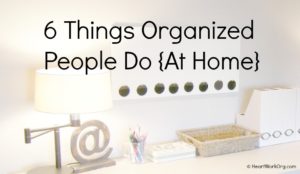 If you come to my house, you won’t see a perfect, magazine-ready home. But you will see a clutter-free, tidy space, unless the kiddos are having a LEGO-fest. Then all bets are off.
If you come to my house, you won’t see a perfect, magazine-ready home. But you will see a clutter-free, tidy space, unless the kiddos are having a LEGO-fest. Then all bets are off.
Want a more clutter-free home all the time? Take note of things that organized people do to keep their home organized.
While there are many more things that organized people do, these 6 things that organized people do might help you to stay more on track in your own home.
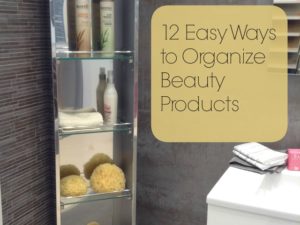 Organizing your beauty products will cut down on the time it takes to get ready in the morning and will start your day off on an organized, empowered note. Here are 12 easy ways to get started:
Organizing your beauty products will cut down on the time it takes to get ready in the morning and will start your day off on an organized, empowered note. Here are 12 easy ways to get started:
1. Keep only the items you use every single day in your medicine cabinet. Leave room for the basics like your toothbrush and skincare. At least that part of your routine can be simplified to just one product for each step, even if you have a million choices for color and finishing touches.
2. For beauty items that coordinate with your outfit or the season, like blushers, eye shadows, and lip color, group them together by category so you can see your choices at a glance.
3. Use clear acrylic drawer dividers or decorative boxes to hold groups of each makeup type in drawers or on shelves.
4. Use wall space by adding bins like those found in kitchens to hang utensils. Add magnetic or hook and loop (Velcro) fasteners to hang items in plain view on the back of the medicine cabinet door. The back of the bathroom door can offer even more storage space with the addition of a clear see-through shoe pocket organizer.
5. The under-sink space is super-high value real estate. Use a 2-tier sliding organizer to make use of all the room under your sink, and to reduce spills and messes.
6. Minimize the amount of beauty product in your tub area. Find a shampoo and body wash that the whole family enjoys using rather than tripping over multiples.
7. Most tubs don’t have much built in storage. Add racks that hang over the shower head and offer 2-4 shelves to hold beauty products and gear. Or suspend another shower rod on the inside back wall at eye level to hold baskets that can hold even more beauty items or bath toys.
8. The 80/20 rule applies to most beauty products. We usually use 20% of our products 80% of the time, and most products get used barely at all. Decide which items are your favorites, and pack the rest away for a month. If you don’t go back into the box to retrieve any of those items, you can probably do without them altogether.
9. Repurpose whenever possible. Use mason jars, wooden boxes that were original packaging for nicer beauty products, and small tin pails from the garden department to help you sort items together and make them look nice.
10. Even simple plastic bins from the dollar store can look great if they are in the same color scheme and labelled nicely.
11. Update your light bulbs. It’s hard to organize what you can’t see.
12. If you are updating your space, ensure there are plenty of drawers to store your beauty products in. Most basic vanities don’t come with drawers. With drawers, you can easily separate your beauty stash and keep your counters clear so you have room to prep each morning.